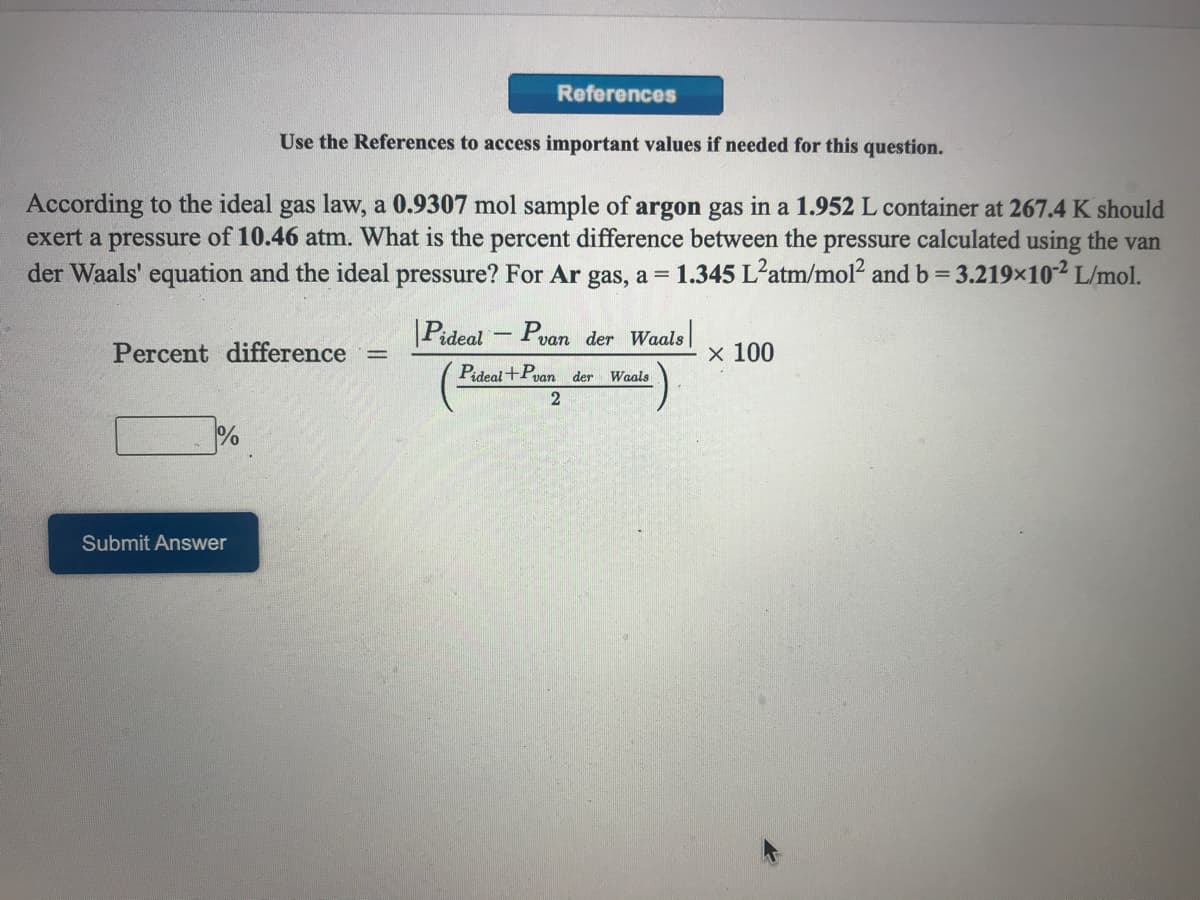According to the ideal gas law, a 0.9307 mol sample of argon gas in a 1.952 L container at 267.4 K should exert a pressure of 10.46 atm. What is the percent difference between the pressure calculated using the van der Waals' equation and the ideal pressure? For Ar gas, a = 1.345 L²atm/mol and b= 3.219x102 L/mol. %3D |Pideal - Pvan der Waals Percent difference х 100 Pideal+Pvan der Waals 0%
According to the ideal gas law, a 0.9307 mol sample of argon gas in a 1.952 L container at 267.4 K should exert a pressure of 10.46 atm. What is the percent difference between the pressure calculated using the van der Waals' equation and the ideal pressure? For Ar gas, a = 1.345 L²atm/mol and b= 3.219x102 L/mol. %3D |Pideal - Pvan der Waals Percent difference х 100 Pideal+Pvan der Waals 0%
Chemistry & Chemical Reactivity
10th Edition
ISBN:9781337399074
Author:John C. Kotz, Paul M. Treichel, John Townsend, David Treichel
Publisher:John C. Kotz, Paul M. Treichel, John Townsend, David Treichel
Chapter10: Gases And Their Properties
Section: Chapter Questions
Problem 56PS: Consider a 5.00-L tank containing 375 g of Ar at a temperature of 25 C. (a) Calculate the pressure...
Related questions
Question

Transcribed Image Text:References
Use the References to access important values if needed for this question.
According to the ideal gas law, a 0.9307 mol sample of argon gas in a 1.952 L container at 267.4 K should
exert a pressure of 10.46 atm. What is the percent difference between the pressure calculated using the van
der Waals' equation and the ideal pressure? For Ar gas, a =
1.345 L'atm/mol? and b= 3.219x10² L/mol.
|Pideal - Pvan der Waals
Percent difference
х 100
%3D
Pideal +Pvan der
Waals
%
Submit Answer
Expert Solution
This question has been solved!
Explore an expertly crafted, step-by-step solution for a thorough understanding of key concepts.
Step by step
Solved in 3 steps with 3 images

Knowledge Booster
Learn more about
Need a deep-dive on the concept behind this application? Look no further. Learn more about this topic, chemistry and related others by exploring similar questions and additional content below.Recommended textbooks for you

Chemistry & Chemical Reactivity
Chemistry
ISBN:
9781337399074
Author:
John C. Kotz, Paul M. Treichel, John Townsend, David Treichel
Publisher:
Cengage Learning

Chemistry & Chemical Reactivity
Chemistry
ISBN:
9781133949640
Author:
John C. Kotz, Paul M. Treichel, John Townsend, David Treichel
Publisher:
Cengage Learning

Chemistry: Matter and Change
Chemistry
ISBN:
9780078746376
Author:
Dinah Zike, Laurel Dingrando, Nicholas Hainen, Cheryl Wistrom
Publisher:
Glencoe/McGraw-Hill School Pub Co

Chemistry & Chemical Reactivity
Chemistry
ISBN:
9781337399074
Author:
John C. Kotz, Paul M. Treichel, John Townsend, David Treichel
Publisher:
Cengage Learning

Chemistry & Chemical Reactivity
Chemistry
ISBN:
9781133949640
Author:
John C. Kotz, Paul M. Treichel, John Townsend, David Treichel
Publisher:
Cengage Learning

Chemistry: Matter and Change
Chemistry
ISBN:
9780078746376
Author:
Dinah Zike, Laurel Dingrando, Nicholas Hainen, Cheryl Wistrom
Publisher:
Glencoe/McGraw-Hill School Pub Co

Physical Chemistry
Chemistry
ISBN:
9781133958437
Author:
Ball, David W. (david Warren), BAER, Tomas
Publisher:
Wadsworth Cengage Learning,

Principles of Modern Chemistry
Chemistry
ISBN:
9781305079113
Author:
David W. Oxtoby, H. Pat Gillis, Laurie J. Butler
Publisher:
Cengage Learning

General, Organic, and Biological Chemistry
Chemistry
ISBN:
9781285853918
Author:
H. Stephen Stoker
Publisher:
Cengage Learning